
NISSAN Micra 3 Doors
Generations Timeline, Specs and Pictures

Nissan refreshed the third generation of the Micra in 2005, three years after the model introduction, and included a more powerful version used only on the 3-door hatchback body.
The European market was highly competitive in the small segment. Most carmakers already had a vehicle that could tick all the boxes for a vehicle of that size. Nissan had to innovate and keep the Micra’s image fresh if it wanted to get better sales results.
With a shape that could fit into the bio-design trend, which was already gone, the Micra tried to get those customers who didn’t appreciate the new-edge-design direction. Its overall appearance was closer to a bubble than to a sharp knife. The front fascia featured a grille split in two by a slat and two oval-shaped headlights mounted high enough to be protected from minor scratches. From its sides, the three-door Micra featured an arched greenhouse and dark edges for the rear side windows. The carmaker added a roof spoiler on top of the tailgate for the SR version.
Inside, Nissan left the same grey-color interior with a curved dashboard that featured the radio mounted between the center air vents. For the sportiest version, it included white-dials in the instrument cluster and aluminum pedals. Unlike its five-door sibling, the three-door version offered tilt and tumble front seats.
Under the hood, the carmaker offered a choice of seven engines. Nissan carried over part of them from Renault. Interestingly, the SR version was available with either a twin-cam 1.6-liter engine or a 1.5-liter turbo-diesel, producing 110 hp.
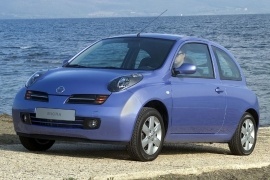
With a refreshed design, a new platform co-developed with Renault and a new range of engines to choose from, the 2003 Micra was a good choice as a city car.
Unveiled at the 2002 Paris Motor Show, the new Nissan Micra was slightly longer than its predecessor, having used the Renaul-Nissan alliance B-platform that was developed for small and compact-sized vehicles. The same platform was used by the Nissan Tiida and the Renault Megane.
The car’s shape and the happy design was more appealing for young women. Both headlights and taillights were mounted high and back to avoid getting them scratched in the parking lot. The shape also contributed to the great visibility offered to the driver.
While from the outside the Micra looked small, it was surprisingly spacious and offered plenty of storage areas in the cabin. It was fitted with front plain seats and a bench for two adults in the rear, or three children. The trunk was limited, but the split-folding rear bench seatback could extend the luggage area if necessary.
For the engine compartment, the Micra was offered with a choice of three gasoline and two diesel engines, mated to a standard 5-speed manual. A 4-speed automatic was available for selected markets and versions.
Besides the more powerful engines available, the fuel efficiency was greatly increased and the emission levels were reduced.
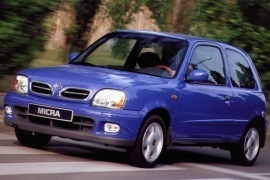
The 2000 release MIcra was the last one to hold its traditional box-appearance before the radical 2003 restyling.
Rounder on the edges and as appealing as all mini-cars, the Micra was released with a choice of two gasoline units with capcacities of 1.0 L and 1.4 L as well as a 1.5 Liter Diesel plant. The 4-cylinder 1.4 L engine, introduced as a replacement for the previous generation 1.3 L, produced 82 hp and 108 Nm of maximum torque. Despite the upgrade, the new engine pushed the car to a top speed equal to that of the 1.3 L. The latter took 12 seconds to reach 62 mph while it took close to 4 seconds more for the 1.4 L to reach the same limit.

The second generation of the Nissan Micra appeared on the market in 1982 and went through a major facelift in late 1997 as a 1998 model.
Nissan saw an opportunity in small vehicles when it introduced the Micra and tried to keep its advantage over the years. But Renault, Peugeot-Citroen, Fiat, Opel, and Volkswagen were there to get a slice of the market. Like the other manufacturers, Nissan produced the Micra with 3- and 5-doors. The Japanese carmaker decided that it was time to refresh its old model with a major facelift in 1997.
From the outside, the 1998 Micra looked very similar to the non-facelifted version, but it featured a new front fascia with a pair of leaves-looking grille separated by a vertical slat that supported the brand’s logo. The three-door version featured longer doors than its five-door sibling. Despite using an older design, the car’s rounded shape was appealing for women more than for men, but that was not a problem as long as the orders kept coming.
Inside, Nissan made a few changes, especially for material quality. The rounded shape of the dashboard and the oval-shaped instrument cluster was considered chic and trendy. To access the rear bench, the front seats were tilted and moved forward.
Under the skin, the 1998 Micra was drastically improved. Along with its refreshed gasoline engines, Nissan also installed a diesel engine bought from Peugeot. To make things better, the Japanese carmaker offered a CVT gearbox, which was available for selected versions.
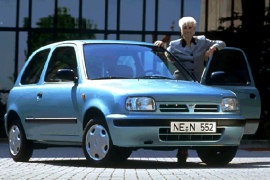
The first Nissan Micra was introduced in 1982 in Japan as Nissan’s response to the successful Honda City.
It was later in 1983 when the small Micra came to Europe and impressed everyone with its practicality and the low fuel consumption.
While the first generation offered a single engine option, the second generation released in 1992 came with two new aluminum units with capacities of 1.0-liter and 1.3-liters. The powerplants developed 65 hp and 74 hp respectively. A diesel version was also available with the 1.5-liter PSA TUD engine.
Besides the 3-door version, Nissan also offered the Micro with a 3-door body style.
The small Micra could be equipped with more safety features that were not common for a car in this class: a safety-cage, side-impact door beams, pre-tensioning seatbelts and a driver’s airbag. Although equipped with the mentioned equipment, the Micra didn’t score well at the Euro NCAP testing, receiving only 2 stars.
Depending on the market, the Micra came with standard or optional airbags, anti-lock brakes, electric windows, power steering, central locking and air-conditioning.
The Nissan Micra was the first Japanese car to win the European Car of the Year in 1993.
While the supermini didn’t have the most stylish exterior design, it proved to be a reliable and easy to maintain vehicle, perfect for city traffic.
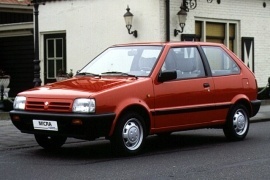
The first generation of Micra was introduced to the market in 1982 and along the road, it was updated many times until 1992 when it was replaced by a new generation.
The original Micra, named K10 on the internal Nissan coding system, was introduced to the market to compete against other Japanese cars and, in Europe, to compete against the French and the Italian vehicles.
The design was very simple, with straight lines, squared headlights, and taillights. In the beginning, it was named Datsun, a brand owned by Nissan. But that faded away and in 1986 the real Micra was unveiled. In 1989 it still featured a square design, but the grille was moved forward and the metal bumpers were replaced with plastic ones due to safety and styling reasons.
Inside, the Micra was a basic vehicle with enough room for four adults, but without too much room in the rear. The Super S version featured a bodykit, sport-bucket seats, and a tachometer. It also featured a stiffer suspension.
Under the hood, the 1989 Micra featured a choice of three gasoline engines. For selected markets, the Micra was available with a supercharger and a turbocharger. The standard transmission was a 4- or 5-speed manual, depending on the engine option. A 3-speed automatic transmission was available as an option.
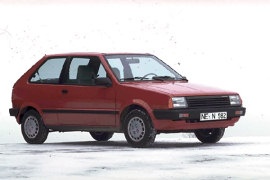
The first generation of the Micra, the K10 model, was launched in an era when the Datsun badges were still on some of Nissan’s vehicles.
It was introduced to Japan market in 1982.
Nissan needed a car to compete against the Honda City and other Japan domestic market brands. The cubist design was initially for sale to the Fiat, but the Italian car-maker went for the project offered by Giugiaro. But for the Nissan board, the project looked very good. The car was introduced in the European market in 1983.
The Micra featured two square headlights with turn-signals on the outside. The plastic grille with horizontal slats was a new approach for the Japanese car-maker. The greenhouse and the raked C-pillar was in the trend of the new, hatchback, trend. The doors covered more than half of the cabin’s length and that was a big advantage, offering easier access to the rear seats.
Inside, the dashboard was flat and straight, with a rectangular shape for the instrument cluster. There were three dials on it: the speedometer, the coolant temperature, and the fuel level. A two-spoke steering wheel hosted the horn button in the middle. There were no power windows for comfort, and no air-conditioning either.
Under the hood, the 3-door Micra received a 1-liter engine offered with 50 hp or 55 hp, mated to a standard 5-speed manual. In 1982, that was a rare feature of a small car. In 1988, a 10.000 limited production series was powered by a supercharged and turbocharged engine that offered 110 hp. It was the quickest Micra ever produced, with a 0 to 100 kph (0-62 mph) time of 7.7 seconds.























































